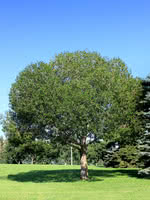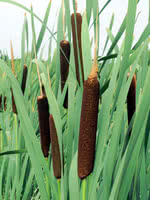Mon-Fri 9am - 5pm Mountain time
Laurel Leaf Willow vs Common Cattail
Salix pentandra
Typha latifolia
CUSTOM GROW
Laurel Leaf Willow is a round-shaped tree with attractive dark green leaves.
This cold hardy tree can withstand bitter winters and still put on lots of growth every summer. Laurel Leaf Willow prefers moist to wet ground and full sun, though it can tolerate partial shade too. This species is also known as one of the more salt-tolerant species for those with saline soils.
All willow are important to native pollinators each spring as they have higher amounts of pollen and nectar early each growing season when other food sources are scarce.
Cattail is found all across North America, growing next to water. Like other waterside plants, Cattail provides erosion control and forage for animals.
It is suitable for land reclamation. Cattail is able to tolerate cold weather and occasional flooding.
Laurel Leaf Willow Quick Facts
Common Cattail Quick Facts
In row spacing: 2.4 - 3 m (8 - 10 ft)

